
We put the R7 2700 & 2700X CPUs through a series of modern benchmarks to see how they hold up in 2023
The Highlights
- The R7 2700 was a very popular CPU that released in 2018
- The CPU shows its age in certain gaming benchmarks like Starfield and Cyberpunk: 2077 - Phantom Liberty
- The 5800X3D is a particular noteworthy upgrade as it allows you to keep your motherboard while getting meaningful gains
- Original MSRP: $300 to $330
- Release Date: April 19, 2023
Table of Contents
- AutoTOC

Intro
Today we’re revisiting the R7 2700 and R7 2700X CPUs. These came out in 2018 and are now over 5 years old. Original launch prices ranged from $300 to $330, with the 2700 often available for around $200-$250 towards the end of its lifecycle. It was one of the most popular CPUs of its time and struck a strong balance with multithreaded application performance, particularly CPU-side streaming (as we showed in our original game + streaming benchmarks from the review). They competed most directly with Intel’s 9900K that launched later in 2018, or the 8700K before that.
This content will show how the older AMD Zen 2000-series parts aged, but also what the best CPU upgrade options are for a similar build today.
Credits
Test Lead, Host, Writing
Steve Burke
Video Editing
Vitalii Makhnovets
Testing
Mike Gaglione
Web Editing
Jimmy Thang
If you’re in the market for a new build, it’s hopefully at least partly because you just want the fun of building a computer. We’ll cover some of the modern replacements to show you the potential uplift as well. Let’s get started.

AMD Ryzen 7 2700 Overview
As a reminder, the R7 2700 and 2700X CPUs were from the earlier days of Ryzen when AMD was still selling the letter “X” for an upcharge. At that time, you could basically buy a non-X CPU and do a 5-minute overclock with experience, or maybe 1-2 hours without any, and save the money while getting X-class performance. The 2700X in our charts today helps to represent the OC performance potential, so remember that this is another avenue to get another small bump out of your CPU without spending money (other than electricity cost). These are 8C/16T CPUs that had a maximum advertised turbo of 4.1GHz, or advertised up to 4.3GHz on the 2700X. The common all-core overclock was around 4.0 to 4.1GHz at the time.

In 2018, we never would have expected the 5800X3D (find the review here) to come out and offer the performance uplift it did. Vertically stacked V-cache is a relatively new innovation stuck to a newer generation of architecture, but retaining AM4 socket compatibility. It’s also still sold. We’ll mostly focus on that today.
Finally, there were recently rumors of other X3D parts coming out soon -- it’s too soon to know if those are true, but this discussion might come back up if they are. The relevant rumor is of an alleged 5700X3D SKU.
AMD Ryzen 7 2700 Modern Pricing: Upgrades
Before really getting into it, we’re going to give some quick pricing updates based on Newegg and Amazon US pricing. These are just from quick searches for parts that will be relevant during this review. We’re splitting attention between new and in-socket upgrade parts. We also included a couple sub-$200 options that we commonly found on the used market. The table below is just designed to get those of you who haven’t paid close attention for a few years up to speed quickly. It doesn’t have every CPU that’s out, but focuses on some of the main ones today.
| Ryzen 2000 | AM4 Upgrade | AM5 Build | LGA1700 Build | |
| $90-$200 | Used R7 3700X ($90-$100) Used R7 5800X ($150) R7 5700X ($185) R7 5800X ($200) | |||
| $300-$400 | R7 2700 ($300) R7 2700X ($330) | R7 5800X3D (typically $320) | R7 7700X (typically $317) R7 7800X3D (typically $390) | i5-14600K (typically $330) i7-13700K ($394) |
| $400-$500 | R9 5900X ($342) R9 5950X ($463) | R9 7900X ($440) | i7-14700K (typically $418) | |
| $500-$600 | R9 7950X ($600) | i9-14900K ($591) |
This table isn’t that advanced and you could obviously add plenty more CPUs to it. Our goal is to isolate the ones we think might be most interesting. We’re assuming someone who bought an R7 2700 is looking to spend a similar amount today.
The 2700 and 2700X were around $300-$330 at launch. At the same price today, you could get an R7 5800X3D -- which we already know is a gaming champion -- so that’ll be high on our list today. You could also get an R9 5950X. It’s a CPU that's focused on non-gaming loads, like heavily multithreaded tasks, and is mostly worth considering if you're desperate to keep an AM4 machine alive while maximizing heavier non-gaming processing. Its biggest downside is that it costs noticeably more than the 5800X3D, at around $463. Newer CPUs give this stiff competition since its pricing is in a higher bracket than the 2700X was originally.
Another option might be the 5800X. It doesn’t have the extra cache. It also saves you some money retailing for around $200-$205 now, but loses a lot in gaming advantage. But you’d still get an uplift. The 5700X won’t be in our charts today. It is very similar to 5800X performance and a bit cheaper. From a charting standpoint, the 5800X and 5700X are interchangeable. If you’re OK with used, then the 3700X is a smaller upgrade for $90-$100, with the 5800X used for around $150 on eBay.
New builds would require a much larger investment as you’ll need a new motherboard and likely new RAM. The same-priced CPU options would be the 7700X and 14600K, with the 7800X3D in a higher price class by pure launch MSRP-to-MSRP comparison, but also a significantly higher performance class.
We listed some other options too just to get you up to speed on the market quickly.
There are a ton of CPUs out there right now, but these are the ones you’ll find most important on our charts today.
We’ll start with gaming benchmarks, then move to production and power -- and the power efficiency changes over the years have been wild, so that’ll be an interesting chart.
AMD Ryzen 7 2700 Gaming Benchmarks

Baldur’s Gate 3 R7 2700 & 2700X Benchmarks
1080p/Medium CPU Comparison
Baldur’s Gate 3 is a new game that ends up being CPU loaded in most scenarios. With its 2023 launch date, it’s 5 years newer than the R7 2700 CPU. We’ll look at CPU numbers here, but you can check our full video on GPU performance in Baldur’s Gate if you need that angle.

In this one, the R7 2700 ran at 51 FPS AVG and held lows proportional to the rest of the average-to-low spacing. For a lot of people, this framerate is probably fine in Baldur’s Gate -- but the venerable 2700 is finally showing its age in big ways. It’s getting into borderline territory. The 2700X would offer about a 10% uplift for an in-socket upgrade, or you could just spend an hour overclocking your 2700 to the same performance levels. We think that’d be worth it to pull another 10% out of the CPU.
If you went and bought a 3700X for about $100 on eBay, you’d get a boost to 60FPS AVG, or a 17% increase over the 2700 and 6.6% over the 2700X. We haven’t rerun the 5700X lately, but the 5800X is similar in performance as a reference point: That’d get you a massive 50% uplift from the R7 2700 at 77FPS AVG, with lows also pulling up strongly. For $185-$200 in the 5700X and 5800X class CPUs, that’d be a strong, single-item purchase for a drop-in upgrade. But the 5800X3D remains the strongest: This one ran at 106FPS AVG, or basically a doubling of the 2700 and 2700X. It’s still available for $322 at the time of this story. There’s the 5600X3D also, but the 5800X3D would be the best you can get in a gaming CPU for AM4.
If you wanted a brand new system for one reason or another, AMD’s same-price modern replacement for your MSRP $300-$330 2700 series CPUs would be the R7 7700X. That one’s at 90FPS AVG. It’ll have benefits elsewhere, like production applications later, but it’s not better than the 5800X3D for a pure gaming user. You’d save a lot of money sticking with one more run of AM4. A worthwhile, next-gen upgrade would have to come in the form of an Intel 14700K, 13900K, or 14900K, all of which will have more benefits in production than gaming. The 7800X3D might make the most sense for its bigger jump, but at $100 higher than your original 2700 purchase price.
1440p/Medium CPU Comparison
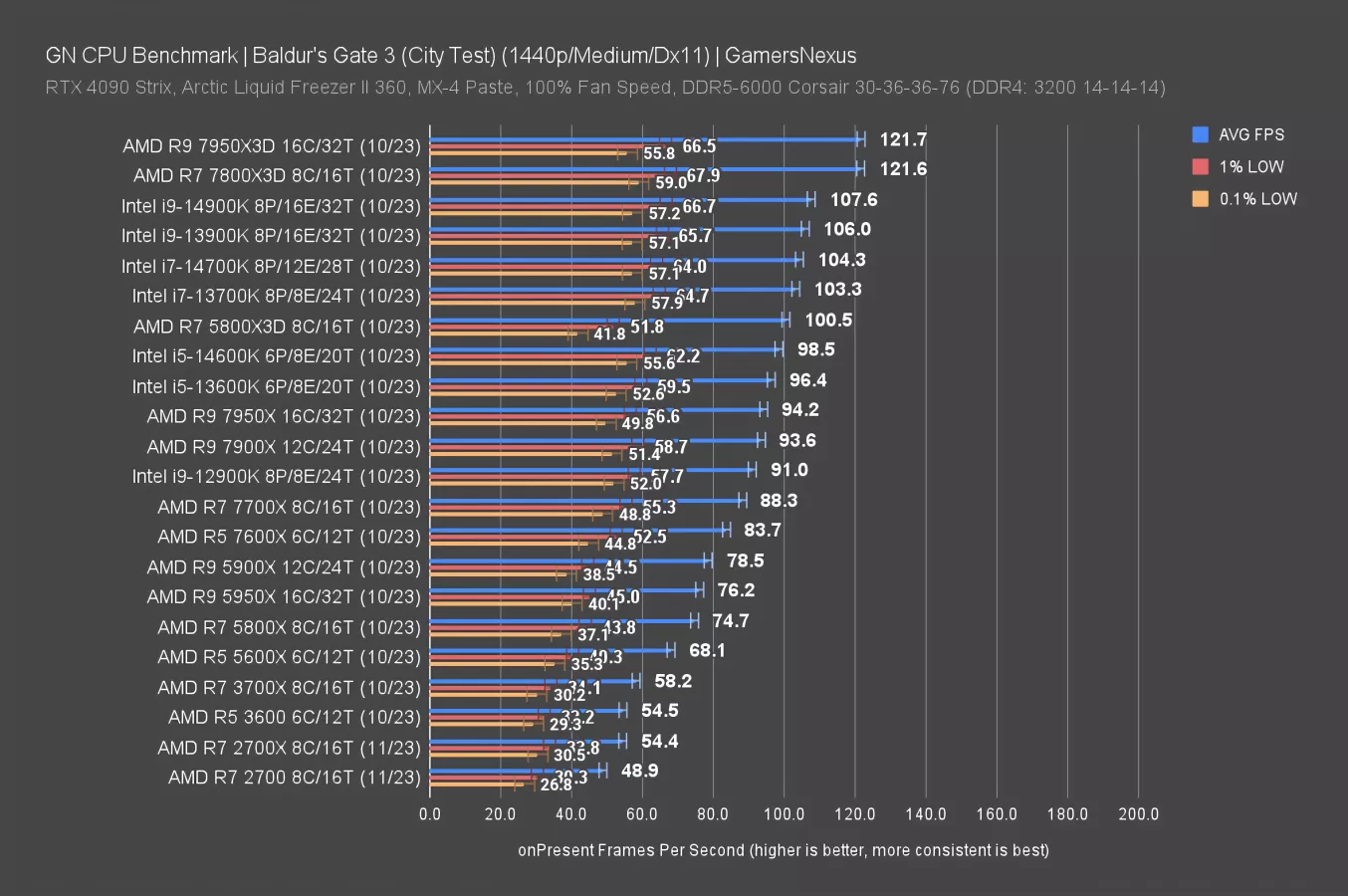
This one will be short. At 1440p, we’re still seeing full scaling. Increasing the GPU load isn’t affecting the results. It would in other games and at high settings, but it’s likely your 2000-series CPU is limiting performance of new GPUs even in higher GPU load scenarios.
AMD Ryzen 7 2700 Cyberpunk: 2077 - Phantom Liberty CPU Benchmarks
1080p/Medium Ryzen 7 2700 Performance

Cyberpunk: 2077 - Phantom Liberty is up now. This is another game that’s effectively brand new and would be a possible driving reason for an upgrade for 2000-series owners. Features like Ray Reconstruction and RT overdrive might make this more of a GPU-focused upgrade, but the CPU still scales a lot in this one. You can learn about Ray Reconstruction in our written article or in our video.
At 1080p/Medium, the R7 2700 ran at 88FPS AVG and held lows at 60 and 46 -- that’s respectable, and actually still perfectly playable. The R7 2700X keeps a 9.5% lead, so again, an overclock on the non-X would get you at least about 10%.
If you wanted an in-socket upgrade to the best option, the 5800X3D would give a massive 100FPS jump. It’s actually insane that these two CPUs were tested in the exact same motherboard with the same RAM. We hope AMD will keep doing this, because even though it’ll make board partners less money, it’s certainly a lot less wasteful and it’s better for consumers. That’s a 111% uplift.
Cheaper in-socket upgrades might include a used 3700X. That’d get you 27%. The lows scale comparably there. Another could be the 5800X or 5700X. The 5800X would offer about a 63% improvement.
For totally new platforms, the 7800X3D offers the most at 200FPS AVG, or 130% improvement. Everything else is below the 5800X3D, but will offer benefits in workstation workloads. The 14600K, 7700X, and 14700K deserve highlights as parts to consider if doing more than gaming.
1440p/Medium - R7 2700X & 2700 Performance

1440p provides similar results, but with a truncated ceiling at 190FPS AVG due to an encroaching GPU bind. Let’s move forward.
AMD Ryzen 7 2700 Starfield CPU Benchmarks (Ryzen 2700 & 2700X)
1080p/Low Ryzen 2000 Benchmarks
Starfield is up next. This is another brand new game, so we have a lot of new titles in this bench suite for your upgrade considerations. We recently ran standalone CPU and GPU benchmark pieces on Starfield (and we’ve published a Starfield Graphics Optimization Guide, too), so you can get the full research from those.
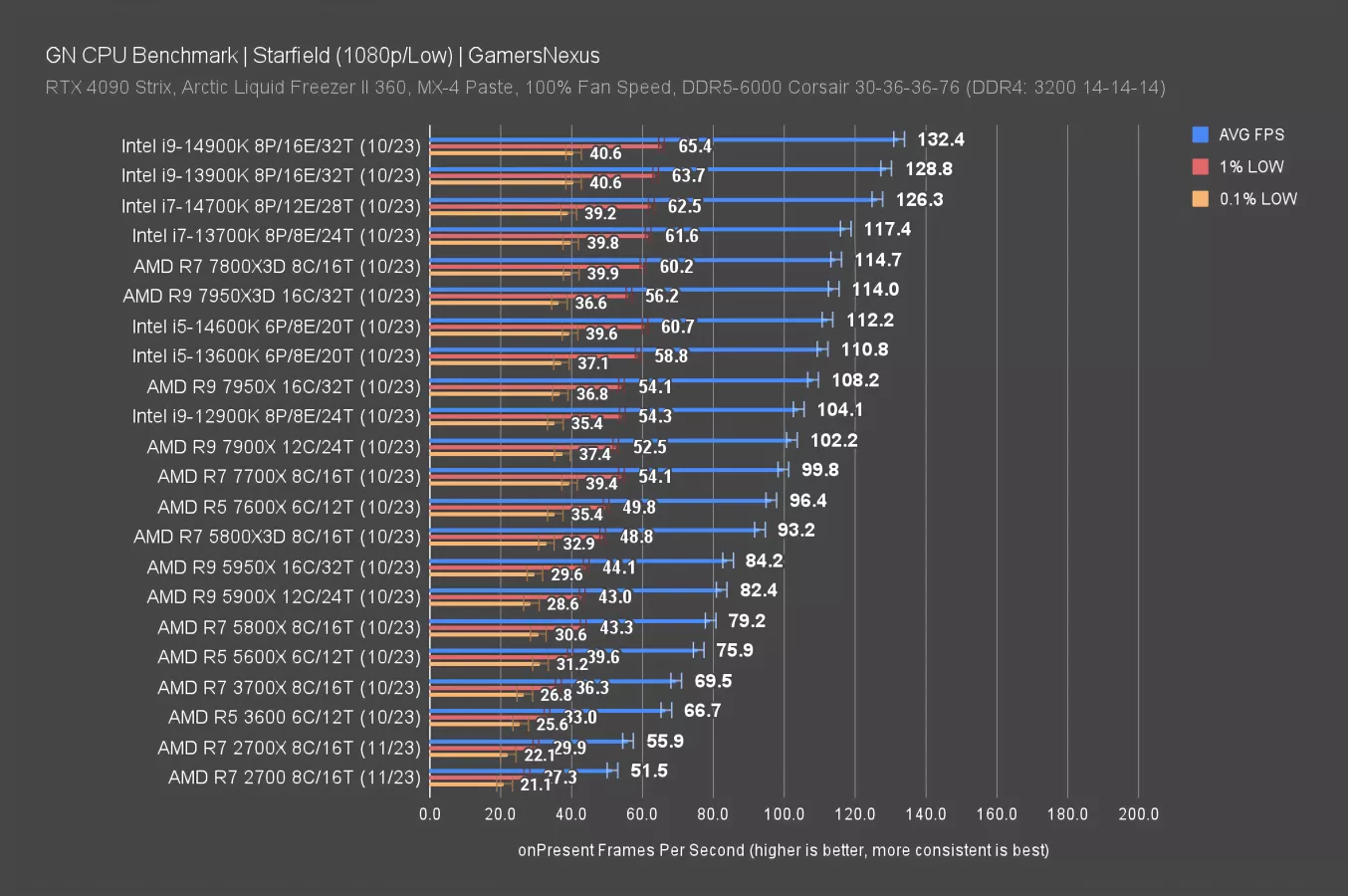
Here’s the 1080p/low chart. The 2700 ran at 51.5 FPS AVG when CPU-bound in Starfield, so that’s another lower FPS number that can prove actually relevant if considering an upgrade. Strapping an “X” to the CPU gave it a 9% boost. In rapid order, the likely upgrade options might include: A 3700X at 70FPS AVG, or 35% ahead of the 2700. The 5800X at 79FPS AVG, or 54% ahead of the 2700. The 5800X3D at a significantly higher 93FPS AVG, or 81% ahead of the 2700 and 67% ahead of the 2700X. The 5800X and 5800X3D would offer a noticeable improvement in frametime consistency when looking at the lows.
New CPU upgrades could include the 7700X, which, in this game, is actually doing technically better than the 5800X3D at 100FPS AVG. The 7800X3D runs at less than half the frametime on average, or more than double the framerate, as compared to the 2700 series. That’s a big jump as well. Intel’s 14700K or 13700K would be the alternatives, providing close to the most you can get out of a CPU in this game.
AMD Ryzen 7 2700 F1 2023: CPU Upgrade Comparison
1080p/High Ryzen 2000 Benchmarks in 2023

F1 2023 is up next.
The framerate ceiling is obscene here: At 511FPS AVG for the 7800X3D, this serves almost more as a synthetic benchmark of scaling at this point. The 2700’s 177FPS result is perfectly fine from a gameplay standpoint. From a relative scaling standpoint, the 2700X at 192FPS AVG would provide a lessened 8% uplift (again, the same as the average OC on the 2700). The 3700X would give 31% over the 2700, or 21% over the 2700X.
The 5800X3D offers a staggering 154% uplift over the 2700, or 136% over the X-SKU. If you wanted the modern I/O capabilities of a new platform, the 7800X3D would boost that to a max of 188% against the 2700. The 7700X comes in lower than the 5800X3D again, but would get you to a new platform while still providing 130% improvement. The 14700K is about the same uplift at 407FPS AVG, with similar benefits of a modern platform for those who know they need them.
1440p/High

At 1440p, the top-end shrinks to a maximum 400FPS average. Scaling shrinks with that, demonstrating that GPU bottlenecks will always lessen the impact of a CPU improvement. Even still, the 2700 and 2700X are old enough that you’d still see improvement in many scenarios.
AMD Ryzen 7 2700 Final Fantasy XIV CPU Benchmarks
1080p Max Graphics Ryzen 2700 & 2700X Performance in 2023
FFXIV is up now. The game has been around for a while now, but remains one of the most popular MMORPGs currently getting played. Also, as far as an MMO goes, it has a relatively high load on modern parts.

Here’s the chart. FFXIV’s benchmark test is interesting mostly because it has favored Intel’s CPUs for a long time now. The 7800X3D and the 12900K mark the start and end of compartmentalized AMD and Intel sections, with Intel holding a generally strong advantage. We think some of this is due to GPU driver behavior as well.
The 2700X leads the 2700 by 11%. The 3700X would boost over the X and non-X by 6.7% and 19%, respectively. The 5800X offers a big in-socket improvement at 46% over the 2700, or 31% against the 2700X. Back to the king -- the 5800X3D -- that’d give a lesser-than-prior but still noteworthy improvement of 71% against the 2700. AM5 as a new platform would limit your gains to about the same as the 5800X3D here, but Intel would give significant advantages: The 14900K establishes a ceiling of 113% improvement over the 2700, with the 14700K at 100% better. The 14600K is similarly boosted.
1440p Max Graphics FFXIV CPU Benchmarks
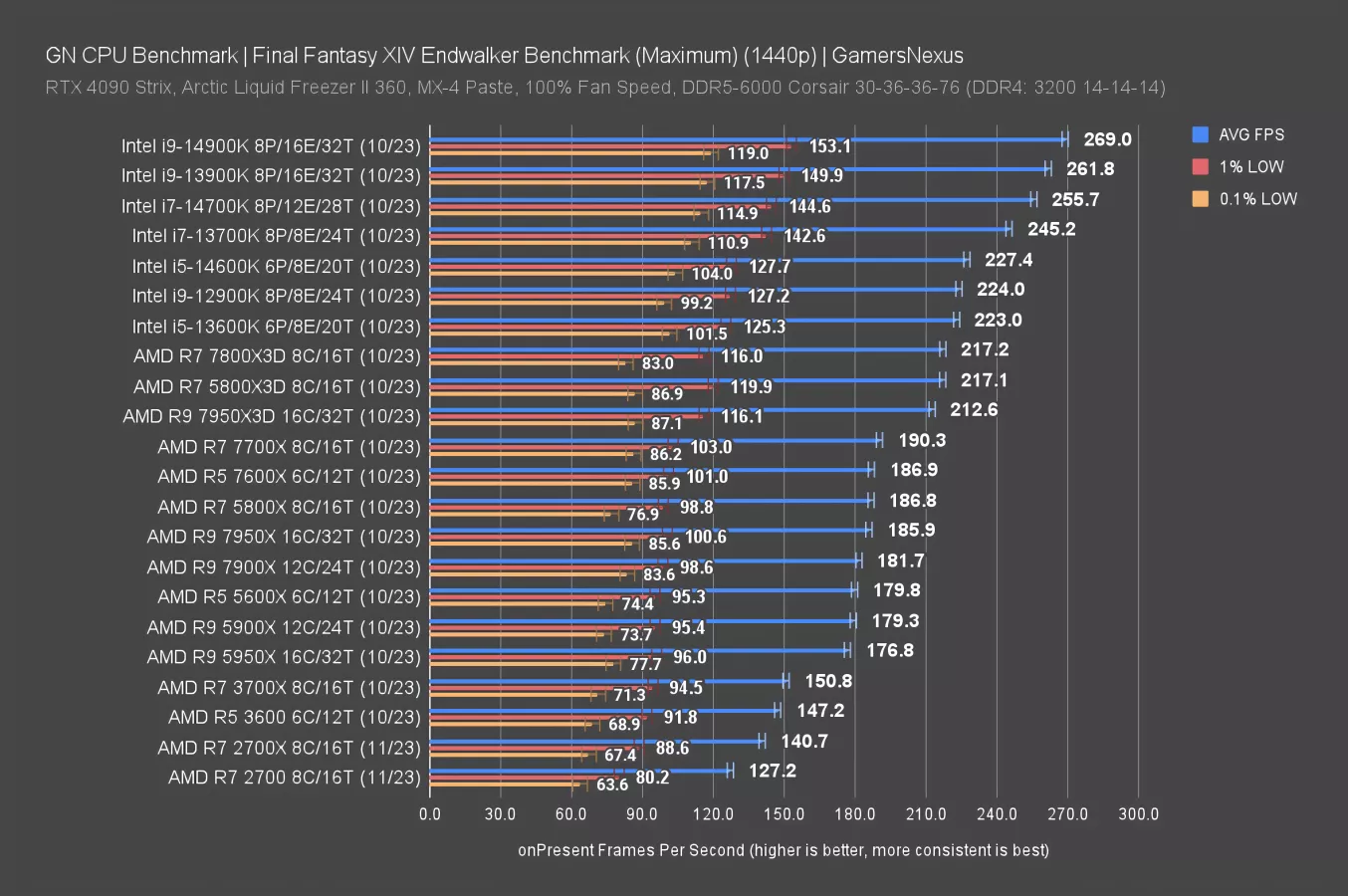
At 1440p, the lineup is similar. There’s nothing new here: The CPU limitation is still the main one, even with max graphics at 1440p. Let’s move forward.
AMD Ryzen 7 2700 Rainbow Six Siege CPU Benchmarks
1080p/Very High Best CPUs

Revisiting the Ryzen 7 2700 and 2700X in Rainbow Six Siege for 2023, we saw the 2700 at 295FPS AVG and 2700X 8.2% ahead at 320FPS AVG. Here’s a rapid fire list of improvement options in-socket:
The 3700X would offer 26% over the 2700, or 17% over the 2700X. The 5800X would provide a large boost of 87% to 552FPS AVG from the R7 2700. The 5800X3D would give a 120% uplift over the 2700, or 103% over the X. The 5800X3D is so comically far ahead that its 0.1% lows are higher than the average of the 2700X -- that’s insane , and illustrates exactly why X3D is such a good upgrade.
Out-of-socket upgrades include the 7700X at 640FPS AVG, or still a doubling and some over the 2700 series CPUs, and the 7800X3D at a ludicrous 717FPS AVG. Intel didn’t even punch this high with APO in our recent tests. The 14700K would be another likely new platform option, running at about the 5800X3D’s performance but with newer platforms and modernized I/O.
AMD Ryzen 7 2700 Stellaris CPU Simulation Time Benchmarks

Stellaris CPU simulation time is next. This one bottlenecks hard at the top-end of performance, where everything from about the 14600K and up can be considered the same.
The 2700 and 2700X show huge room for improvement, though: At 57 seconds and 65 seconds, you’d absolutely notice a halving of the simulation time by moving to a newer CPU. This isn’t just framerate, but a noticeable amount of physical, real time.
The 5800X3D would provide a cut of 48% time required from the 2700. It holds an advantage over the 5800X non-3D as well, despite a lack of similar scaling at the top-end of the chart. The 7700X and 14600K would be new platform alternatives worth considering.
Production Benchmarks
Now we’re moving to the production benchmarks. This section will go fast, but it’ll give us some insight as to the performance in more core-heavy applications. The 5800X3D won’t be as promising here, as the extra cache rarely shows as much improvement in the workstation applications we currently test. Let’s take a look.
AMD Ryzen 7 2700 Blender Cycles CPU Rendering Benchmarks

Blender rendering is up first, using the tile-based renderer to fully load all threads available.
The R7 2700 required 27 minutes to render a single frame of the GN Logo. The best result here is the 7950X, which reduced the time required by 76%. In other words, in this test, you could render 4.2 frames on the 7950X for every 1 frame you render on the 2700. That’s a huge improvement.
The 2700X was 12% time reduced, with the 3700X reducing the time requirement by 28% over the 2700 and less over the X. The 5800X3D doesn’t see benefit here from V-cache. If you went with a 5900X or 5950X as an in-socket upgrade for more production-focused builds, you could get maximally a 63% reduction in time per render. That’s great for users who do less gaming and more of this kind of work.
New builds would offer a 70% time cut with the 14700K at 8 minutes as compared to the 2700.
AMD Ryzen 7 2700 Compression and Decompression CPU Tests
7-Zip Compression
Next is compression testing using 7-Zip. This would be useful if you do a lot of file compression.
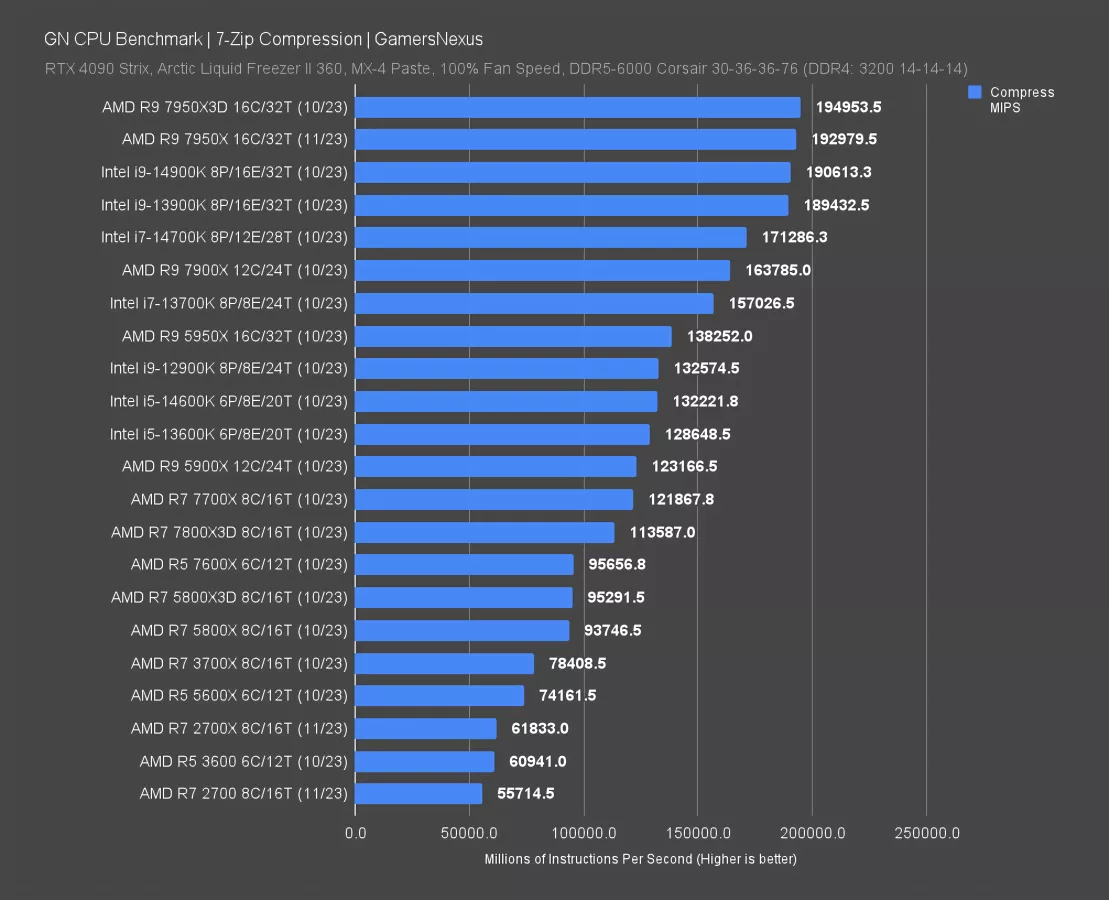
The 2700 completed 56,000 MIPS, or millions of instructions per second. The 2700X was 11% faster, with the 5800X offering a 68% improvement over the 2700. Going up to a 5950X in the same socket would offer a 148% faster compression time over the 2700. A new platform would need movement to a 7900X or 14700K to get meaningfully above the 5950X, unless you just need other features of new boards. The 7950X leads this chart, at 193K MIPS.
7-Zip Decompression
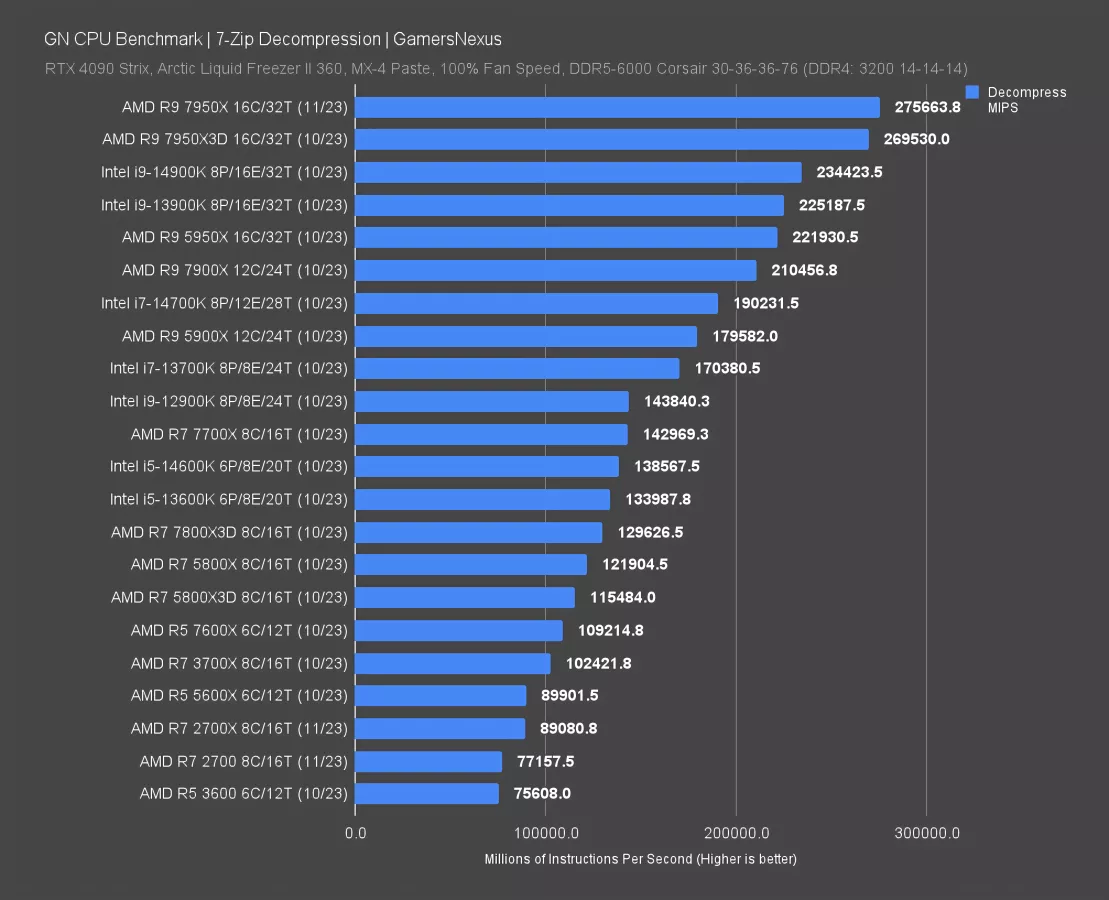
Decompression shuffles the stack a little bit. The 2700 and 2700X run at 77K and 89K MIPS, respectively. It’d be worth overclocking the 2700 for this kind of performance if you plan on staying with it. The 7700X would offer a significant improvement for a new platform, although the 5950X runs impressively far ahead for its age -- and again, it ran in the same motherboard as our 2700. The best new Intel option here would be the 14900K, but it’s priced in a different bracket. The 14700K and 14600K are hard to get excited about as compared to the 5950X or 5900X.
AMD Ryzen 7 2700 Adobe Premiere Benchmark

Adobe Premiere CPU benchmarking with the Puget suite has the 2700 at 454 points in aggregate, tied with the 3600 and giving the 2700X its standard 9% advantage. The 5800X gives a 33.7% improvement in the same socket, with the 5950X a bit above that. For a new build, the 7700X would get you 62% better performance than the 2700, offering a meaningful improvement for Premiere users. It’s not shown in this chart, but the biggest point of improvement was in intraframe and RAW performance.
On the Intel side, the 14600K would give a 65% uplift, with the 13700K and 14700K at 76% and 81% better.
Best CPUs for Adobe Photoshop in 2023
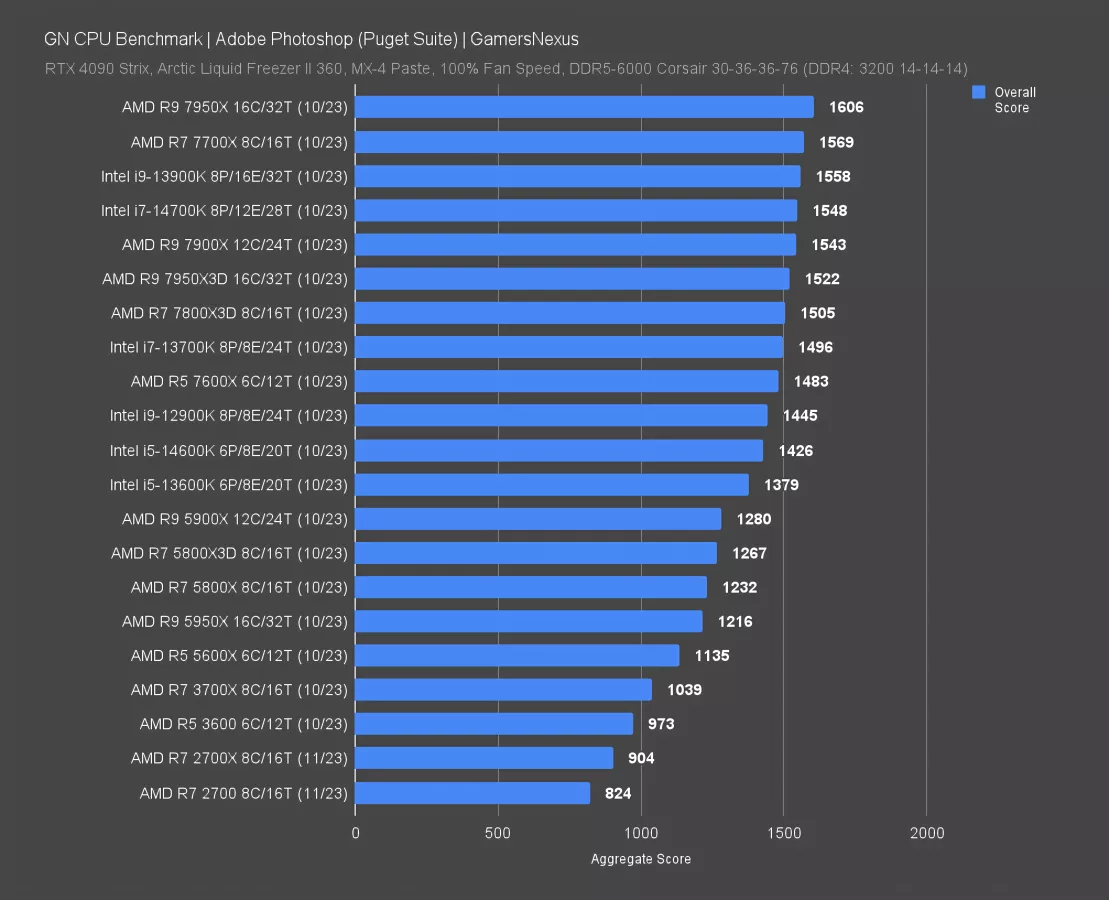
Finally, in Adobe Photoshop, the chart leaders in the 1500 to 1600 range show scaling room approaching 2x improvements. Extra cache isn’t helping in Photoshop, but the 7700X at 1569 points sees its biggest contribution in the filter score and GPU score, where the GPU can be better leveraged. Almost anything would be an upgrade here -- other than maybe the R5 3600.
AMD Ryzen 7 2700 Power Consumption Benchmark

For power consumption, the R7 2700 pulled about 76W in an all-core workload. Our overclock was a bit over-the-top back in the day, pushing it to 180W but improving performance notably. You could fine-tune this a little lower. The biggest improvement in modern CPUs though is the efficiency: Despite higher outright stock power consumption in something like a 7700X, at 148W, or 5800X3D at 108W, the output per Watt is much higher. CPUs in the 14-series are huge power consumers, especially the 14900K at 287W and 14700K at 284W.
AMD Ryzen 7 2700 CPU Efficiency Comparison

Finally, we’re looking at efficiency. This is judged using Blender render time against power consumed, with the unit of measurement as Watt-hours. In terms of energy efficiency, the 2700’s 33.9 Watt-hour result had it more efficient than a 14900K, but it’s obviously far less effective in performance. In other words, the 14900K will complete more work in much less time, but given a fixed unit of work, the 2700 will require slightly less energy doing it. The 7700X offers a notable efficiency uplift, at 31.1 Watt-hours. The 5950X remains one of the most efficient CPUs we’ve ever tested, thanks to its fine-tuned and low Vcore.
AMD Ryzen 7 2700X 2023 Revisit Conclusion

For most people, as long as you don’t need that “all-new-stuff” itch, you can get a huge amount of punch out of a last-chance upgrade with the 5800X3D. You probably won’t need a new motherboard (but check the BIOS support) and you won’t need new RAM. You could even keep your operating system. This would be the lowest-hassle upgrade possible. It’s likely your cooler would be fine, and a repaste is probably good for it. A new GPU would give the most possible “efficiency” in terms of performance per dollar, and that’d also be an easy change. An overclock might also be fun for giving another small bump, especially if hanging on to the 2700(X) a little longer.
For anyone who’s less on the gaming side but heavy on the production side, it might be worth considering a used 5950X.
One reminder too: A lot of people who see decaying performance over the years are actually suffering more from operating system bloat than they are from the CPU itself. If you’re trying to save as much money as you can, doing a clean install might be a good intermediary step to see if you can revive some performance. It doesn’t always work, but users with a cluttered OS (especially driver bloat) can see benefit.
New Gaming PC Builds

Ultimately, the 2700 and 2700X still work well in a lot of scenarios. Anyone more sensitive to framerate or things like render times would benefit from an upgrade, but these CPUs are far from obsolete. They still run most of these games well overall.
For those who just want the fun of building a fully new computer, the similarly priced modern options would be the 7700X or 14600K. Both offer large uplift in overall performance, but nothing compared to the 7800X3D for gaming uses. The 7800X3D in particular is a strong part, posting the highest overall gaming performance right now. If it helps you cope and mentally justify it, the $300 you spent on a 2700 would be worth about $370 today, after inflation, so that’s basically a 7800X3D. Then again, maybe thinking about the loss of value makes it worse.